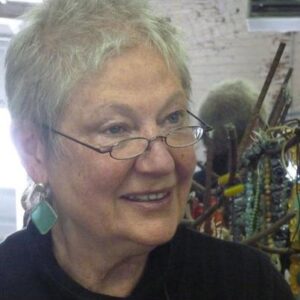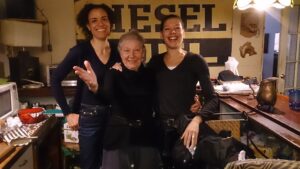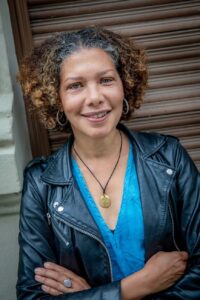Episode 217
What you’ll learn in this episode:
- How Saudia is preserving her mom Cara Croninger’s legacy
- Why Cara Croninger’s resin and plastic jewelry was—and still is—groundbreaking
- How Cara Croninger refined her jewelry making process, and why she didn’t want her pieces to be perfect
- What it was like to grow up in an artistic family in the heyday of New York’s art jewelry scene
- How Saudia’s mom and dad influenced her music career today
About Saudia Young
Saudia Young is a New York City-born actress/singer and storyteller in theater and film. Born on the Lower East Side and brought up between Tribeca and LA, Young explores the notion of home, love, justice, and identity through her art.
The recently repatriated artist lived in Berlin, Germany, for a long chapter of performing, writing, and producing. The Ameripolitan Awards 2023 Female Rockabilly Singer nominee released her 7″ single ‘Noir Rockabilly Blues,’ produced by Lars Vegas-DE and featuring ‘The Wobble’ on the A and Iggy Pop’s ‘Lust for Life’ on the B side, in 2017, followed up by her 12” debut ‘Unlovable’ in 2018. The LP was recorded live at Berlin, Germany’s legendary Lightning Recorders.
Young founded a Dark Kabarett and a Rockabilly Noir Blues band in Berlin, co-created the Lost Cabaret and the Schwarze Liste Kabarett theater projects and wrote and produced the award-winning short film The Gallery. While in Berlin, she was cast in the lead voice-over role of Oskar in School for Vampires (the English version of the Hahn Film cartoon series).
Young co-wrote and performed the solo show Sneaker Revolution and is currently writing a theater/film piece about her actor father, Otis Young, and sculptor/designer mom Cara Croninger.
Photos:






Additional Resources:
Transcript:
To jewelry lovers, Cara Croninger was a groundbreaking artist whose work was shown at iconic galleries Artwear and Sculpture to Wear. To musician and actress Saudia Young, she was just mom. Today, Saudia is working to preserve her mother’s legacy and secure her place in art jewelry history. She joined the Jewelry Journey Podcast to talk about how Cara made her pioneering resin jewelry; how Cara’s work evolved with the times; and why Saudia thinks of her mom every time she performs. Read the episode transcript here.
Sharon: Hello, everyone. Welcome to the Jewelry Journey Podcast. This is the first part of a two-part episode. Please make sure you subscribe so you can hear part two as soon as it’s released later this week.
Today, we’re speaking to my guest, Saudia Young, who is located in Philadelphia. She has an interesting background. Her mother was a very well-known jeweler, and her father was an actor. She was born in New York and grew up between New York and Los Angeles. She is New York material. You will be surprised to hear that she developed a career as an actress, a writer and a singer. She’s described as having a whisky voice, and I think that’s true, a caramel whisky voice. She was a nominee in 2023.
Saudia: Thank you so much for having me. I’m really glad to come on to your show for the second time. It was the Ameripolitan Music Awards. I was simply nominated for female rockabilly singer. There are lots of different categories and full bands. Jane Rose won for the rockabilly female singer that year. They’re moving on, but it was very exciting to come after 15 years in Germany to participate in that. I’ve met a lot of awesome people because of that.
Sharon: I know you’ve lived in several places, but I didn’t know for 15 years, you say, in Berlin?
Saudia: Yes.
Sharon: Wow! Now you’re in Philadelphia this evening.
Saudia: Yes.
Sharon: Is that your home?
Saudia: It is for now. It’s where my sister lives. I have a sister from my mother and my father. He had other children, so that’s why I clarify that. I’m spending some time with my sister. I’ve been back and forth in the States since my mom passed in 2019. I’m honestly trying to figure out where I’m going to live. It’s not clear because of Covid and my mom passing, but it’s been a lot.
Sharon: 15 years being in one place.
Saudia: Yeah, so I’m here for now. I feel like I can’t commit to saying this is my home. It’s like, “Let’s see what it brings. Let’s see what happens.” It’s great to hang out with my sister. I’m close to my mom’s work, which is stored now in Hackensack, New Jersey. I moved it from New York. My mom’s work has had more of a tour than I have.
Sharon: Cara Croninger is your mom’s name. Even though she passed—I’m very sorry to hear that—she’s still very well-known. She has an exhibit in the Smithsonian?
Saudia: No, it’s simply her papers, photographs, articles, fashion editorials. As you know, she bridged fashion and art. She was in both worlds. She had a toe or a foot or whatever in both worlds, so she has been accepted into the Archives of American Art at the Smithsonian. That means they have letters, her correspondence to other artists and gallerists and whomever, any type of reviews, sketches, all her boxes of papers and some photographs. It’s an honor. It was sad to let that go, but it’s also awesome because that means it’s helping to secure her legacy.
It will eventually be uploaded digitally so people will be able to look at it. You can go into the archives and look up different artists and see their papers. For example, one of my favorite things were letters from Floriana Frassetto, who founded Mummenschanz and was one of her best friends. She always wrote these beautiful letters to her. She would call her Cara Mia. She was Swiss-Italian. So, it’s just that, showing the ephemeral items in her life.
Sharon: You’ve been on this program before. You were among our first guests—
Saudia: Yeah.
Sharon: If you want to listen to it, it’s on TheJewelryJourney.com. We’re so glad to have you back again.
Saudia: Thank you.
Sharon: Tell me why your mom’s jewelry was different. What was the breakthrough? Why are they keeping her papers?
Saudia: I think because of that bridge. She wasn’t craft. She came as a sculptor. Her jewelry was made of acrylic and polyester resin, although she did work in other materials like metals. She started off painting, but the work was always very sculptural and almost avant garde. It went from very organic and indigenous and African influenced to futuristic. It was solidly in the art world, but also solidly in the fashion world when she was with Robert Lee Morris’ gallery, Artwear, and before that, Sculpture to Wear.
Artwear blew up and it was very, very popular in the press and in fashion magazines. All the top models were wearing it. People like Iman would come to the gallery openings. It was part of that whole exciting time in the 80s in New York, seeping a little bit into the 90s, but mostly in the 80s. It was in the late 70s and throughout the 80s that they had their heyday. There were other artists in this gallery that are now working and very well-known, like Ted Muehling, Robert Lee Morris himself. Carol Motty, may she rest in peace, was a very, very good friend of my mom. She worked in silicone.
Sharon: I’m sorry. I don’t know her.
Saudia: Carol Motty. She did wild, neon-colored, awesome pieces in silicone rubber. She was unique in that it literally was a bridge of art and fashion. That’s what she built. I think that was her significance. In terms of the materials, the pieces cost anywhere from $40 to $4,000 or more. She raised the level of this material, which is plastic resin and acrylic, polyester resin, to a very high level. It would get the same price that silver and gold and gemstone jewels would get because of the beauty, the workmanship, that she put into it. The work is known for having this sensual beauty. A lot of the pieces have a wonderful weight. They have a talisman magic to them. People often will collect the pieces. You even collected some pieces.
Sharon: Yeah, I did. I love them.
Saudia: It’s kind of magic. She herself as a person was a beautiful, down-to-earth, but funny and effervescent person. People loved meeting her. They loved collecting the work.
Sharon: What was the role you and your sister played?
Saudia: We were her daughters. We did help make work. There were points where we learned how to do the finishing work. We never did the pouring, creating the pigments or the molds, but we could help with finishing. We’d be her child laborers and work on the sanding machine or polishing or drilling holes or what have you. We were able to do finishing work. Because we grew up with it, we understood the shapes and her style, but even growing up with it, there was always some kind of tension. She would say, “That’s your style. That’s not mine.” It wasn’t easy because it was so organic and very unique. That made it hard for her to have people work for her.
Sharon: When you would attend these parties or an opening night at the galleries, did you know who the celebrities of the day were? Were you aware?
Saudia: Yeah, I was in my early 20s or so. At one point, my sister and I both worked at Artwear. We were both looking forward to working with Robert. That was always really fun. Even the artists were celebrities to us because they were so talented and vivacious and positive. I knew a lot of the models, the supermodels, Pat Cleveland and whomever, but since my dad was an actor, I grew up already having certain people in my life. I was trained for that to be not that big of a deal because I just grew up in that.
When my parents met, they were in the Village in the 60s. James Baldwin was a good friend of my dad, and he was allegedly my godfather. It was a smaller world in a way. Definitely, the 60s and even the 80s feel like a more innocent time than now for some reason. I met different celebrities just on my own, and you felt like they were New Yorkers. I knew Jean-Michel Basquiat and I was like, “He’s just a kid.” I had no clue.
Sharon: Wow! So, this wasn’t a new milieu to you. You knew the big names—I would call them big names—who would come over for dinner. They were around you.
Saudia: Yeah, but it wasn’t—now we’re going back even before Artwear. It was normal to me. I didn’t notice it. It was just part of being a kid in New York, a kid of artists. You know what I mean?
Sharon: But your mother was making this jewelry that I would call groundbreaking. Today we look at it and go, “Oh, it’s a piece of plastic,” but it was groundbreaking then.
Saudia: Yeah, it was definitely groundbreaking. I think it still is because there are few people who can work in it, like Patricia von Musulin, who’s an amazing artist who works with acrylics. There are some people who can work with it. There’s Alexis Bittar, who borrowed a lot of designs from my mom. There are people who can work with it and it’s beautiful, but often you see stuff that’s mass produced overseas. It doesn’t have a good feeling; it just feels cheap. Her work still has this magic weight to it. But as I said, as kids, we didn’t know. It was just, “My mom’s an artist. She’s working at her studio making her stuff.”
Sharon: Was her studio a separate place or was it where you lived?
Saudia: She had many different studios. She had a shared space in Gowanus in Brooklyn, a huge foundry that had 80-foot ceilings that she shared with approximately five other artists. Now, I’m jumping back and forth with timelines. I’m not great with timelines. She had a studio in Dumbo, Brooklyn, at 68 Jay, which was a 2,000-square-foot, awesome studio that she lived in illegally. Our formative years when we were little were on the Lower East Side, but we lived in Tribeca when it was still very industrial. We first started off on Washington Street in an apartment. I think it was a three-bedroom apartment that I recently got to visit again, which was amazing.
She cordoned off a little section of that Astor studio, and then what happened? O.K., when we were at Washington Street, she was able to be one of the resident artists in the Clocktower, which was a studio project where Alanna Heiss was organizing unusual spaces for artists to either create their work or show their work. My mom was one of several artists who were in the Clocktower. That’s where she actually met the artist who showed her how to work with plastics. I don’t know what his name was.
Sharon: So, she wasn’t working with plastic until she met these people?
Saudia: Yeah. She started off painting and doing leatherwork, painting on leather, sewing leather bags, fringe work, Japanese-style obi belts. That’s what she started doing first in terms of accessories and crafts.
Sharon: Did your friends know she was a big name, let’s say?
Saudia: No, we were all pretty clueless. A lot of our friends were kids of painters. We related to them as workers, like this is what they did for their work. My mom was the lady who made great bread. She made homemade bread, and she made great chicken. People would come over and eat. She was a very social person. We had extended family members, but I don’t think my friends thought of her as that famous, not really.
Sharon: I was going to ask you why she wouldn’t let you pour, but that made her work. That’s her name.
Saudia: I didn’t have any desire to pour. As a teenagers, at 18? No desire. I was off doing my own thing. I had my own ways of expressing and my own life. That was her thing.
Sharon: What colors did she like? I’ve seen some pieces, but I know she had a whole range.
Saudia: She worked in an amazing array of colors. She loved vibrant primary colors. She also worked in colors that were more organic, that were reminiscent of ivory or amber. She would do pours. I think we spoke about this. She would do a pour about once a year. It was always a big deal for her to get the emotional wherewithal to do a pour. Also, I think she was aware of the toxicity. She only wanted to pour during the summer, when the windows could be open and the heat would help the plastic pour faster.
She would always think about, “What am I going to pour?” It might be a ruby red, which was really popular and beautiful. One of the most popular pours, I think I said in the last interview, was the black and white, where she would have black and white and it would come out in a striped formation. Then she would pour into her different molds, the bangles, the C cuffs, the earrings.
Just as important as the colors were the processes. For the slice earrings, she would pour the layers so it would be striped into a block like a loaf of bread, a small, little, long brownie. Then she would slice it on a bandsaw and you would get to see the stripes. Part of her process was the actual cutting, carving, sanding to get the shapes, and then making the decision whether she was going to have them polished or matte without polish.
Sharon: A mask?
Saudia: Matte, sorry. What the finish would be. If she had faceted bangles or hearts or whatever, she was very aware of not making anything perfect. She used the fact that it had scratches to show the layers of work and to show that it’s made by a human. It wasn’t something that needed to be absolutely perfect. She was very into wabi sabi, the Japanese art of the imperfect. She loved wavy shapes and asymmetry in her designs.
Sharon: Who did the selling for the first years, when you were getting it off the ground?
Saudia: I was a kid, so I wasn’t going to get it off the ground. I was just eating the food she was putting in the refrigerator. When she first started with the leatherwork, she was just going around to different boutiques in the Village or whatever and selling them, either having them buy it straight out or on consignment. I think one of the worker’s galleries was the original Sculpture to Wear. That was near where MAD Museum is right now. I’m forgetting the name of the hotel. That was one of her galleries. I’m sure there were other stores I don’t know about.
That was in 1971 or something like that. That was very close to when she started working in plastic. She got taken in and accepted really quickly. At that time, Robert Lee Morris was also selling at Sculpture to Wear. He was a wunderkind. He was opening up his own gallery, Artwear, and brought my mother into that gallery. During that time, that also gave the artists recognition and amplified their voices. They were able to have their work in stores in Boston and in California because of being in Artwear.
Sharon: We will have photos posted on the website. Please head to TheJewelryJourney.com to check them out.

